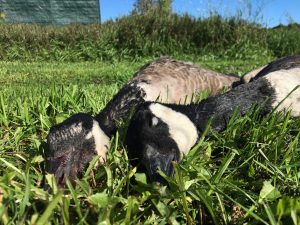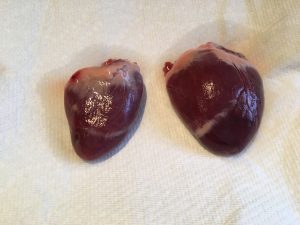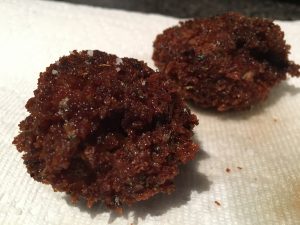It’s a total cliché to call turkey hunting an obsession. There is a camo pattern bearing that label, there is a web series about it, and there are thousands and thousands of people who have written about it, many of them in arguably better fashion than I have.
Yep, it is an absolutely tired cliché. But the reason it is tired is because it is all-too-true.
I’ve always thought of myself as reasonably level-headed. On occasion, especially in my much younger decades, I did some unusual things. Early in my turkey hunting career I was obstinate and inflexible, and it cost me birds. I still sometimes have impulses like that, even though I seem to have learned that a hunter has to sometimes adapt in order to kill turkeys. Last year was one such example, and it paid off in absolutely unexpected success. But this year, through a combination of opportunity and frequency, I can say without reservation that I was officially “obsessed”. This obsession was with three ornery tom turkeys that live around a patch of ground I hunt in Simcoe County. This is my tragic story.
I was in my local spot on the opening Saturday of the season with my Dad a few hundred yards southwest of me. This spot is on a privately-owned chunk of hardwood and some swamp surrounded by a couple fields and some more privately-owned hardwoods and fields. The other locations are closed to us, although I have seen vehicles in the past parked at those areas so no doubt other turkey hunters frequent them on occasion. Access locally can be tough, so we’ve always been very cautious about staying on ‘our side of the line’, but that adds to an already challenging hunt. My first solo tom came off this local property and I’ve had frequent close encounters there when, through fate or hubris, I was not able to seal a bird.
Just a few days prior, Dad had been in a run-in at this location with a couple of cagey toms that snuck in silent on him, and he couldn’t contort himself into a shot. It was a frustrating hunt he said, but it gave me hope that birds would be frequenting the area. I settled in against a large boulder as the breaking dawn brightened everything around me. As if on cue, three gobblers fired off at 5:20am in the posted land to the north. They gobbled well, once breaking into a musical round that saw one tom finish and another immediately start, only to have the third bird holler as the second finished his chorus. It was “Row-Row-Row Your Boat” wild turkey style, and it went on for three minutes.
I had chills and I could sense I was grinning idiotically behind my camo face mask.
Their gobbles changed as they hit the ground and then they fell silent. A hen rasped away in the woods behind me and the toms briefly made their way in my direction. They went quiet again before moving off to the west, and I got a text message from Dad that he could see them half a kilometer away strutting and not showing any interest in moving our way. We called it a morning.
The weekend after, I killed a bird on the Bruce Peninsula in very memorable fashion, and it gave me hope that I’d be able to tag out on a Simcoe County bird with the remaining three weeks of turkey season still laid out in front of me.
The following weekend, while my brother and father were on the Bruce Peninsula themselves each harvesting turkeys, I was back at the local spot. Once again, the three gobblers were loud and proud, roosted in the exact same property north of our access that they had been in the weekend before. Once again, they were responsive on the roost and once again they flew down and showed passing interest in my calling before once again heading due west into inaccessible areas. Of course, while all this was happening I was fortunate enough to be treated to a wonderful, if not slightly cool, spring morning with sightings of deer, coyotes, waterfowl, and hundreds of raucous songbirds. That afternoon, my six-year old son went with me for his first ever turkey hunt, and although a hen circled us at twenty yards for a good fifteen minutes, the gobblers were silent. Driving out, I spotted them in that same area they had been moving to every morning.
They had a pattern, and there wasn’t a damn thing I could do about it. Not legally, at least.
Fast forward ahead to the next weekend, a glorious three-day weekend with the promise of incredible turkey hunting weather. The forecast was sunny and calm, but also just a few degrees on the cool side. I love this as it keeps the mosquitoes down in the swampy spots of the property.
For a third hunt, the toms were in the same tract of hardwoods and for the third time they flew down and went north-west. I held out just a but longer in the morning and fired them up after 8:30am, but a single shot from where I last heard them quite literally crushed my spirits. They went silent and I packed up my things and moped to the car. I drove out past the block where I had last heard them and was shocked to see the three birds strutting in the block just adjacent to where the shot had come from. I was grinning like an idiot again, because either a fourth bird had met his end in that area or some unfortunate hunter had missed. I’ve felt the sting of the miss myself before (and probably will again before I shuffle off) but I was pleased to see three longbeards alive and well within earshot of my preferred patch. I resolved to be back on the holiday Monday.
It was a carbon copy of the previous hunt. Gobblers hollering in the hardwoods to the north, that flew down into the field, gobbled some more, and never paid my calling any attention. They were telling me something and I resolved to get out at least one more time and put a theory to the test. You see, previously, I had waited for them to gobble before calling back, and the result had always been the same: lukewarm to moderate interest in my setup before heading northwest of my direction into places I just cannot go.
Next time out I was going to be the one to wake them up.
I got in extra-extra early with my Dad on the last Saturday of the season. This time it was offering to be hot and humid and I had my Thermacell loaded and ready to do work. I also had my mind made up that those birds were going to hear me long before I heard them. After all, what was there to lose? At the precise moment legal shooting light hit, I thumbed the shells into the 870 that makes every trip with me, and I pulled out a crystal pot call. I tree yelped and did a fly down series at just barely past 5am; even at that early hour, the late-spring morning was bright. In those moments between calling and waiting for an answer, I was a jumpy bundle of nerves. I was waiting for the response that had come so predictably every other morning of the season.
Nothing. I ratcheted up the volume on some yelping. Still nothing. I cutt hard and rasped so loudly on the call that my ears tingled just a bit.
From the hardwoods to the north came the shouted response from that trio of birds, and I exhaled with a smile.
They answered every cutt and yelp, and on fly down they showed more interest than at any other time this year. They slid off slightly just before 6:00am, but they were still answering when I went into a fighting purr sequence (which my pot call does so well that it almost isn’t fair), and they thundered back. Before I could call, they hammered again, closer this time. I set the call down and steadied the gun. Again, they gobbled, and they sounded angry then. I was sure they were in my field for the first time all season, and my heart picked up the pace just a bit. I cut my eyes left, hoping to see their forms heading into my hen and jake decoy setup. They gobbled hard and they sounded to be nearly in range, but still I did not have a visual on them as they approached from my left. I steadied the gun in their direction and twisted my left shoulder imperceptibly towards them.
Then, it all went to hell.
In that slightest movement a white-tailed deer busted from less than fifty feet to my right and ran out of the woods, on a bee-line between the decoys and where I had last expected to see those three gobblers. Tail-up and bounding along, snorting all the way, the doe crossed the field. I held the gun steady in the last spot I’d heard a gobble. Everything was so blasted silent that it made me temporarily believe that the turkeys had simply vanished into thin air. I had not heard them putt and I had not heard them fly, so I clung to the hope that the deer had not pooched my whole hunt and they were still sneaking in. For ten minutes I was silent, waiting to hear a turkey drumming or for another gobble to ring out. Eventually I clucked on my mouth call and nothing happened. I yelped louder, and still nothing happened. I cutt and yelped and the three birds responded…hundreds of yards to the northwest, headed to where they had gone every other morning this year.
I lowered the gun, muttered an unrepeatable swear word and resolved to apply for a doe tag for that WMU so that I could come back and turn that deer into backstraps.
Shortly after Dad came by and I told him my pathetic story. He’s always been fatalistic about things like that, and with a shrug and soft smile he said “if they were easy to kill, there wouldn’t be any of them left” which is true but was of cold comfort to me in the moment. I was pretty annoyed at the turkey-hunting gods by that time, having just gone through the full emotional wringer in a matter of a few early-morning hours and been oh-so-close to actually laying eyes down the gun-rail on those three birds that had occupied my thoughts and mornings for the whole spring. But it was not in the cards.
In the self-reflective moments of the drive home, I realized how obsessive about these birds I had become and that through the lack of Sunday hunting in the township, along with work and family commitments, I was not going to get another crack at them this spring. There was closure in that, and I was simultaneously frustrated at the outcome and grateful for the opportunity to tangle with them. Aside from one of them actually dying at the end of my shotgun, they really were everything us turkey hunters hope for. They were vocal, they had personality, and they were some of the most challenging birds I’ve had to work against. My wishful thinking imagines them as hardy four-year-old birds with dragging beards and wicked hooked spurs, brothers that had lived their whole lives in the area and that I may have had run-ins with in prior springs. They very well could be, or they could just be unpredictable, contrary two-year-old toms that like all wildlife don’t really have a set of rules that they follow and just do frustrating things to people like me.
I wish for them to make it through the next ten months or predators and cars and another Ontario winter, so that come next April I will find myself seated in the same spot sparring with them once again; all I can do is hope that by then perhaps I’m a little better and that maybe they have an off day.



